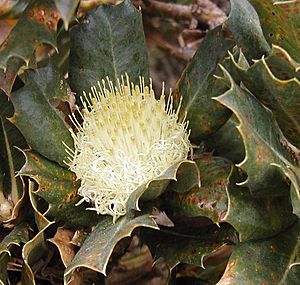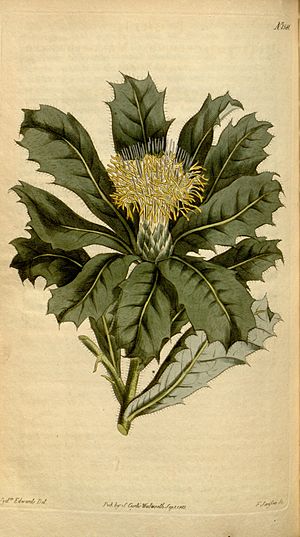Banksia sessilis var. cordata facts for kids
Quick facts for kids Banksia sessilis var. cordata |
|
|---|---|
 |
|
| Conservation status | |
| Scientific classification |
|
| Kingdom: | Plantae |
| Clade: | Tracheophytes |
| Clade: | Angiosperms |
| Clade: | Eudicots |
| Order: | Proteales |
| Family: | Proteaceae |
| Genus: | Banksia |
| Species: | |
| Varietas: |
B. s. var. cordata
|
| Trinomial name | |
| Banksia sessilis var. cordata (Meisn.) A.R.Mast & K.R.Thiele
|
|
| Synonyms | |
|
Dryandra sessilis var. cordata (Meisn.) A.S.George |
|
Banksia sessilis var. cordata is a special type of Parrot bush plant. It's known for having bigger leaves and flower heads than other Parrot Bush varieties. This plant is quite rare. You can only find it in the very southwest part of Western Australia.
Contents
What Makes It Special?
This variety of Banksia sessilis is similar to its relatives. However, it has some unique features. Its leaves can grow up to six centimeters long and four centimeters wide. This is much larger than the leaves of the common Banksia sessilis var. sessilis, which are usually only two to three centimeters long.
The leaves of Banksia sessilis var. cordata are also a darker green. Plus, its flower heads are generally bigger.
How It Got Its Name
Scientists use a system called taxonomy to name and group living things. This plant variety was first described in 1848. A botanist named Carl Meissner gave it the name Dryandra floribunda var. cordata. He based this on a plant sample collected by James Drummond.
Meissner didn't fully explain the name "cordata." But he did mention the leaves were cordatis, which is Latin for "heart-shaped." So, the name "cordata" means its leaves are shaped like a heart.
Later, in 1870, another botanist, George Bentham, described a similar plant. He called it D. floribunda var. major. This plant was found near Cape Naturaliste. He also connected an old painting of D. floribunda from 1813 to this variety.
Over time, scientists changed the names. In 1924, Dryandra floribunda became Dryandra sessilis. Then, in 1996, Alex George moved var. cordata to Dryandra sessilis.
The most recent change happened in 2007. Two scientists, Austin Mast and Kevin Thiele, moved all Dryandra plants into the Banksia group. That's why its full scientific name today is Banksia sessilis var. cordata (Meisn.) A.R.Mast & K.R.Thiele.
Where It Grows
Banksia sessilis var. cordata only grows in a specific part of Western Australia. This area is called the Warren region.
You can find it in two separate places:
- Along the west coast, between Cape Naturaliste and Cape Leeuwin.
- Along the south coast, between Point D'Entrecasteaux and Denmark.
It likes to grow in sandy soil that has limestone underneath. It's often found among coastal heath plants.
Growing This Plant
This variety is not very common in gardens. However, experts believe it would need similar care to the more well-known Banksia sessilis var. sessilis. This plant might do better in places that are cooler and wetter.
Protecting This Plant
The Department of Environment and Conservation keeps a list of rare and important plants. On this list, Banksia sessilis var. cordata is marked as "Priority 4 - Rare."
This means that scientists have studied it enough. Even though it's rare, it doesn't seem to be in danger of disappearing right now.



